
Understanding Synthetic Aperture Radar (SAR) Satellite Imagery
What is Synthetic Aperture Radar (SAR)? When people think of satellite images, they often picture colorful photos taken from space.
Are you not able to find out which is the best DJI mini drone, worry not we are going to answer you in few minutes with out complete guide of DJI Mini 3 vs DJI mini 3 Pro. When it comes to choosing the perfect drone, there are always so many factors to consider, right? Whether you’re just starting out or you’ve been flying drones for years, picking the right one can be tricky. If you’ve been eyeing DJI’s Mini series, you’re probably wondering: should you go for the DJI Mini 3, or does the DJI Mini 3 Pro suit your needs better?
Honestly, it’s not as straightforward as it may seem, especially because both of these drones pack a punch when it comes to features and portability. But here’s the thing – while both drones share some similarities, like the compact design and easy-to-carry weight, there are some key differences between them that might make one a better choice for you depending on what you need.
In this blog, we’re going to dive deep into DJI Mini 3 vs DJI Mini 3 Pro. We’ll go beyond just the specs and talk about how these drones actually perform, which one offers better features for photographers, content creators, or even casual users, and why one might be a better fit for your flying style than the other. So, whether you’re someone who just wants to fly for fun or you’re thinking about using a drone for professional shoots, we’ll help you figure it out.
And let’s be real: the Mini 3 comes at a more budget-friendly price, but that doesn’t mean it compromises too much on performance. On the flip side, the Mini 3 Pro is like a high-end option for those who need something a bit more powerful, especially when it comes to camera quality and safety features.
By the end of DJI Mini 3 vs DJI Mini 3 Pro comparison, you and I are going to walk through all the details together so you can decide which drone best suits you, your budget, and your flying style. Sound good? Let’s get into it!
When comparing the DJI Mini 3 and DJI Mini 3 Pro, we carefully evaluated the most important features that will impact your user experience. Here are the 8 key criteria we considered:
The camera is one of the most crucial elements of any drone. We compared both models based on their camera sensors, megapixels, and video resolution to determine how well each drone performs in capturing high-quality images and videos.
Battery life can make or break your drone flying experience. We evaluated how long the Mini 3 and Mini 3 Pro can stay airborne, as well as how quickly their batteries drain and recharge, ensuring you get the most out of your flight time.
For users who travel frequently or need a lightweight, portable drone, weight and dimensions are critical. We compared the ease of transporting both models and their compliance with various aviation laws that limit drone weight.
Both drones come with advanced transmission systems, but how far can they go while maintaining a reliable connection? We compared their transmission distances and the quality of the live video feed during flights.
Safety features like obstacle sensing play a major role in preventing crashes. We looked at the sensing capabilities of both models, assessing which provides better obstacle detection and collision avoidance systems.
Smart features can enhance your flying experience, making complex shots easier to capture. We compared the available intelligent flight modes, such as QuickShots, ActiveTrack, and FocusTrack, to see which drone offers more creative control.
Wind resistance can drastically impact your drone’s stability in the air. We assessed how both models perform in varying weather conditions, ensuring that they remain stable even when flying in moderately windy environments.
Finally, we examined the pricing for both drones, including package options like Fly More Combos, and evaluated whether the extra features of the Mini 3 Pro justify the higher price compared to the Mini 3.
Feature | DJI Mini 3 | DJI Mini 3 Pro |
Weight | 248g | <249g |
Dimensions (Folded) | 148 x 90 x 62 mm | 145 x 90 x 62 mm |
Dimensions (Unfolded) | 251 x 362 x 72 mm | 251 x 362 x 70 mm |
Camera Sensor | 1/1.3-inch CMOS, 12 MP | 1/1.3-inch CMOS, 48 MP |
True Vertical Shooting | Yes | Yes |
Max Video Resolution | 4K @ 30fps | 4K @ 60fps |
Flight Time | 38 minutes | 34 minutes |
Transmission System | DJI O2 | DJI O3 |
Max Transmission Distance | 6km | 8km |
Sensing Systems | Downward | Forward, Backward, Downward |
ISO Range (Video) | 100-3200 | 100-6400 (Auto), 100-6400 (Manual) |
ISO Range (Photo) | 100-3200 | 100-6400 (Auto), 100-6400 (Manual) |
Shutter Speed | 2-1/8000 s (Electronic Shutter) | 2-1/8000 s (Electronic Shutter) |
Max Image Size | 4000 x 3000 | 8064 x 6048 (48 MP), 4032 x 3024 (12 MP) |
Still Photography Modes | Single Shot, Timed, JPEG | Single Shot, Interval, JPEG + RAW, Panorama |
Zoom Capabilities | 4K: 2x, 2.7K: 3x, FHD: 4x | 4K: 2x, 2.7K: 3x, FHD: 4x |
QuickShot Modes | Dronie, Helix, Rocket, Circle, Boomerang | Dronie, Helix, Rocket, Circle, Boomerang, Asteroid |
Color Profiles | Normal | Normal, D-Cinelike |
Supported File System | FAT32 (≤32GB), exFAT (>32GB) | FAT32 (≤32GB), exFAT (>32GB) |
Max Speed | 16 m/s | 16 m/s (S Mode), 10 m/s (N Mode), 6 m/s (C Mode) |
Max Ascent Speed | 5 m/s | 5 m/s (S Mode), 3 m/s (N Mode), 2 m/s (C Mode) |
Max Descent Speed | 3.5 m/s | 5 m/s (S Mode), 3 m/s (N Mode), 1.5 m/s (C Mode) |
Max Wind Speed Resistance | 10.7 m/s (Level 5) | 10.7 m/s (Level 5) |
Operating Temperature | -10°C to 40°C (14°F to 104°F) | -10°C to 40°C (14°F to 104°F) |
Hovering Accuracy Range | Vertical: ±0.1 m, Horizontal: ±0.3 m | Vertical: ±0.1 m, Horizontal: ±0.3 m (vision pos.) |
Video Transmission System | DJI O2 | DJI O3 |
Live View Quality | 720p @ 30fps | 1080p @ 30fps |
Latency | Approx. 200 ms | Approx. 120 ms |
Antenna Setup | 2 antennas, 1T2R | 4 antennas, 1T2R |

So, let’s talk about one of the most important features when choosing a drone: the camera. This is often the first thing that catches the eye, especially for folks like you and me who are into photography and videography. Both the DJI Mini 3 and the Mini 3 Pro come equipped with a 1/1.3-inch CMOS sensor, but here’s the catch: the Mini 3 Pro takes the lead with its 48MP sensor. This means it delivers way more detailed images than the Mini 3, which only has a 12MP sensor.
Now, you might be thinking, “Is this really a big deal?” Well, if you’re just flying for fun, maybe not. But if you’re looking to create stunning visuals or you want your photos to pop, that extra detail can make a world of difference. Plus, the Mini 3 Pro can shoot 4K video at 60fps, while the Mini 3 tops out at 4K at 30fps. For those who crave smooth, professional-looking footage, that higher frame rate is definitely a game-changer.
|
Feature |
DJI Mini 3 |
DJI Mini 3 Pro |
|
Camera Resolution |
12MP |
48MP |
|
Video Resolution |
4K @ 30fps |
4K @ 60fps |
|
ISO Range |
100-3200 |
100-6400 |
|
QuickShot Modes |
Dronie, Helix |
Dronie, Helix, Asteroid |
Now, let’s talk about those QuickShot modes that both drones offer. These modes let you capture stunning shots without a ton of hassle. You can do cool stuff like Dronie, Helix, Rocket, Circle, and Boomerang. However, the Mini 3 Pro throws in an extra Asteroid mode, which is pretty neat for getting creative. So, if you’re all about those unique angles and shots, the Mini 3 Pro might be the way to go!
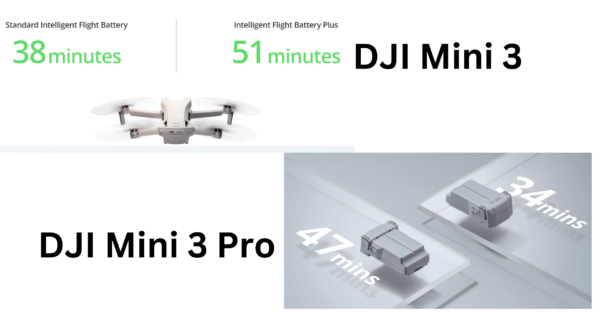
Now, when we switch gears to flight performance, both the DJI Mini 3 and Mini 3 Pro really impress, especially considering how compact they are. The Mini 3 boasts a flight time of 38 minutes, giving you a bit more time to capture that perfect shot compared to the Mini 3 Pro’s 34 minutes. You might think, “What’s a few minutes?” But honestly, every second counts when you’re up there, trying to get the best footage possible.
In terms of speed, both drones can reach up to 16m/s, which is around 35 mph. This speed is more than enough for most casual and professional situations. However, the Mini 3 Pro comes with some added safety features, including advanced obstacle sensing that we’ll dive into later.
Feature | DJI Mini 3 | DJI Mini 3 Pro |
Max Speed | 16m/s | 16m/s (S Mode) |
Flight Time | 38 mins | 34 mins |
Wind Resistance | 10.7 m/s | 10.7 m/s |
Operating Temperature | -10°C to 40°C | -10°C to 40°C |
Both drones are built to handle wind speeds of up to 10.7 m/s, which is pretty good, especially for a mini drone. This means you can fly confidently in most conditions. Plus, they both operate effectively in temperatures ranging from -10°C to 40°C. So, whether you’re out in the cold or the heat, they’re ready to roll.
So, let’s dive into one of the key differences between the DJI Mini 3 and the Mini 3 Pro: the transmission system. The Mini 3 Pro is equipped with the cutting-edge OcuSync 3 (O3) transmission system. This means it can offer an impressive transmission distance of up to 8km and provides a full HD live view at 1080p @ 30fps. Honestly, this makes it a fantastic choice for those long-range missions where you need that clear video feed, especially in areas with heavy interference.
Now, on the flip side, we have the Mini 3. This one uses the older O2 transmission system, which maxes out at 6km and provides a 720p @ 30fps live view. While this might be just fine for hobbyists and casual flyers, if you’re someone who needs that extra range and superior image transmission, you’ll probably lean toward the Mini 3 Pro. It’s all about what works best for you, right?
Transmission System and Range:
Feature | DJI Mini 3 Pro | DJI Mini 3 |
Transmission System | OcuSync 3 (O3) | O2 Transmission System |
Transmission Distance | Up to 8 km | Up to 6 km |
Live View Quality | 1080p @ 30fps | 720p @ 30fps |
Use Case | Ideal for long-range missions, areas with heavy interference | Suitable for hobbyists and casual flyers |
Let’s be real for a moment—safety is super important when it comes to flying a drone. The DJI Mini 3 Pro really steps up its game in this department compared to the Mini 3. With advanced features like forward, backward, and downward obstacle sensing, the Mini 3 Pro is built to help you navigate through more complex environments. Meanwhile, the Mini 3 only comes with downward sensors, which might limit its abilities in tricky situations.
Both drones include DJI’s Return to Home (RTH) feature, which is a lifesaver. It makes sure that your drone returns to its launch point if it loses signal or if the battery is running low. However, the Mini 3 Pro doesn’t stop there. It goes above and beyond with its Advanced Pilot Assistance Systems (APAS) 4.0, which allows the drone to automatically avoid obstacles while it’s in the air. This is pretty awesome, especially if you’re flying in crowded or complicated spaces.
When it comes to wind resistance, these drones can handle wind speeds up to 10.7 m/s—that’s about equivalent to a fresh breeze. Pretty solid, right? This level of wind resistance puts them on par with some of the larger DJI drones, like the Air 2S and Phantom 4 Pro V2.0. However, let’s be real—these drones perform best in mild conditions. Flying them in stronger winds? It might impact their stability and the quality of your video. So, keep that in mind when you’re planning your flights!
Now, let’s dive into safety, which is something we should all take seriously. The Mini 3 Pro really takes the lead here. It comes with DJI’s Advanced Pilot Assistance Systems (APAS) 4.0, allowing the drone to automatically dodge obstacles during flight. The Mini 3, however, only has downward sensors, meaning it can’t see what’s in front or behind it.
This makes the Mini 3 Pro a much safer choice if you plan to fly in tricky environments where obstacles might pop up. Plus, both drones come with a Smart Return to Home (RTH) feature, ensuring they can automatically return to their launch point if they lose signal or run low on battery. That’s a nice safety net to have, isn’t it?
Now, if you’re serious about your aerial shots, the Mini 3 Pro is equipped with some fancy tracking capabilities. It has advanced obstacle sensing and FocusTrack features, including:
These features really make the Mini 3 Pro a superior choice for anyone looking to do professional videography or tackle more complex flying tasks.
DJI Mini 3 vs DJI Mini 3 Pro based on safety and navigation features:
Feature | DJI Mini 3 | DJI Mini 3 Pro |
Obstacle Sensing | Downward sensors only | Forward, backward, and downward sensors |
Return to Home (RTH) | Yes | Yes |
Advanced Pilot Assistance Systems (APAS) | No | APAS 4.0 – Automatically avoids obstacles |
Navigation in Complex Environments | Limited due to lack of advanced obstacle sensors | Excellent with advanced obstacle sensing for better navigation |
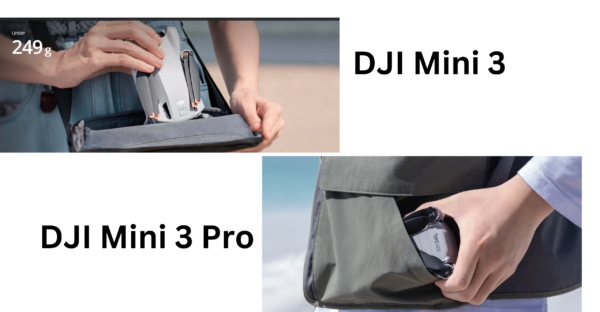
When it comes to portability, both the DJI Mini 3 and Mini 3 Pro are incredibly lightweight, weighing in at under 250g. Their foldable designs make them super easy to carry around, which is perfect for us—vloggers, travel content creators, and even some commercial drone operators who need a drone that won’t weigh them down.
Because of their small size, both drones fall into the A1 Open Category. What does that mean for you? It means you can actually fly them over people (but, of course, not over crowds) without having to deal with a bunch of extra certifications. This is such a huge advantage for beginners or anyone looking for a hassle-free flying experience. So, if you’re just starting out or you want a drone that you can easily take anywhere, both of these options are fantastic choices.
DJI Mini 3 and DJI Mini 3 Pro:
Feature | DJI Mini 3 | DJI Mini 3 Pro |
Weight | Under 250g | Under 250g |
Design | Foldable design for easy portability | Foldable design for easy portability |
Portability | Super lightweight, easy to carry | Super lightweight, easy to carry |
Category | Falls under A1 Open Category (allows flying over people, but not over crowds) without extra certifications | Falls under A1 Open Category (allows flying over people, but not over crowds) without extra certifications |
Ideal for | Great for vloggers, travel content creators, and beginners who need a portable, easy-to-fly drone | Also ideal for vloggers, travel content creators, and beginners, with added features for slightly more advanced operators |
Hassle-free flying | Yes, suitable for beginners looking for a simple, certification-free flying experience | Yes, suitable for beginners and those who want more advanced features with minimal regulatory hurdles |
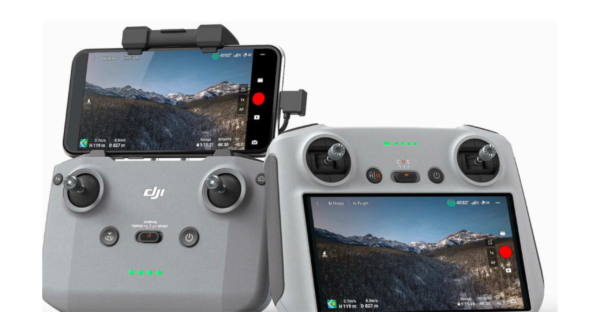
Let’s talk about the controllers for the DJI Mini 3 and Mini 3 Pro. Both drones work with the DJI RC-N1 and DJI RC controllers, and they’re great choices. But, here’s where things get interesting: the DJI Mini 3 Pro also supports the DJI RC Pro. This advanced controller has a built-in screen, so you don’t have to rely on your smartphone while flying. Now, isn’t that a relief?
For those of us who want to avoid interruptions from calls or texts, having a built-in screen is a game-changer. Let’s be real, who hasn’t been distracted mid-flight by a notification popping up? With the DJI RC Pro, you don’t have to worry about that. Plus, the screen brightness is ideal for use in direct sunlight, which is a huge bonus when you’re trying to capture that perfect shot.
The DJI RC-N1 is still a great choice, especially if you’re looking for flexibility with screen size by using your smartphone. However, using your phone can be a bit of a hassle, not to mention it drains your battery quickly. So, if you’re someone who prefers simplicity and no distractions, the smart controllers with built-in screens might be more your style.
Let’s break down the key specs of each controller:
Battery life is always an important factor. The DJI RC Pro gives you around 3 hours, while the regular DJI RC lasts about 4 hours. Now, if you’re using the RC-N1, just keep in mind that it will drain your phone’s battery, so bring along a power bank or be prepared for shorter flights.
The Mini 3 Pro supports the DJI RC Motion 2, which allows you to control the drone with hand movements! Pair it with the DJI Goggles and you’ll get a fully immersive flying experience. Cool, right?
At the end of the day, it’s all about preference. If you’re like me and prefer a distraction-free flight, the DJI RC Pro or DJI RC with a built-in screen is perfect for you. But if you’re on a budget and don’t mind using your smartphone, the RC-N1 works just fine too. It’s really about how you want to fly and what feels right for you.
So, in summary:
| Feature | DJI Mini 3 | DJI Mini 3 Pro |
|---|---|---|
| Controller Options | DJI RC-N1, DJI RC | DJI RC-N1, DJI RC, DJI RC Pro |
| Built-in Screen | No (Requires smartphone connection) | Yes (With DJI RC Pro and DJI RC) |
| Screen Size | Supports devices up to 180mm x 86mm x 10mm | 5.5-inch built-in screen on DJI RC and RC Pro |
| Brightness | Depends on smartphone brightness | 700 cd/m² (DJI RC), 1000 cd/m² (DJI RC Pro) |
| Battery Life | 6 hours (with no phone charging) | 4 hours (DJI RC), 3 hours (DJI RC Pro) |
| Distraction-Free | No (Can get calls/notifications on smartphone) | Yes (No need for phone, avoids interruptions) |
| Control Method | Smartphone required | Can use DJI RC Motion 2 for hand movements |
| Weight of Controller | 387g (without phone) | DJI RC: 390g, DJI RC Pro: 680g |
| Transmission Range | Up to 6km (CE) | Up to 8km (CE) |
| OcuSync System | O2 | O3 |
| Compatibility with Goggles | No | Yes (With DJI Goggles Integra & Goggles 2) |
When it comes to flying our drones, battery life is a big deal, right? We all want to maximize our time in the air and minimize the downtime. So, let’s take a closer look at how the DJI Mini 3 and Mini 3 Pro stack up in the battery department.
Honestly, both drones come equipped with similar battery features, so you can expect reliable performance from either. Here’s what we found:
| Features | DJI Mini 3 | DJI Mini 3 Pro |
|---|---|---|
| Battery Capacity | Intelligent Flight Battery: 2453 mAh | Intelligent Flight Battery: 2453 mAh |
| Battery Weight | About 80.5 grams | About 80.5 grams |
| Voltage | 7.38 volts | 7.38 volts |
| Battery Type | Lithium-ion | Lithium-ion |
| Charging Range | 5° to 40° C (41° to 104° F) | 5° to 40° C (41° to 104° F) |
| Charging Duration | Roughly 64 minutes with a 30W USB-C Charger | Roughly 64 minutes with a 30W USB-C Charger |
Now, let’s talk about how quickly we can get these batteries charged up. For everyday flying, the Mini 3 impresses with a quick charge time, while the Mini 3 Pro takes just a bit longer. Here’s what to expect:
DJI Mini 3: With a 30W charger, it can power up its standard Intelligent Flight Battery in about 38 minutes. That means you can spend more time capturing those stunning shots or exploring new places without too much waiting around.
DJI Mini 3 Pro: It’ll take around 47 minutes for the same battery with a 30W charger. While it’s only a few minutes longer, if you’re all about efficiency, you might want to keep that in mind.
So, if you’re looking for extended airtime, both drones offer an optional Intelligent Flight Battery Plus. However, charging times do vary:
Mini 3: Charging the Plus battery takes about 52 minutes with a 30W charger. Not too bad when you consider the longer flight duration you’ll get in return.
Mini 3 Pro: Here, the Plus battery takes roughly 65 minutes to charge with a 30W charger. The extra time is due to the larger capacity, which definitely pays off with more flying time.
If you’re anything like me, waiting around for a battery to charge can be a real drag. Here’s how each drone handles fast charging:
DJI Mini 3: The cool part? You can use a 65W charger for fast charging, which slashes the standard battery charging time down to just 25 minutes! That’s perfect for us pilots who want to get back in the air ASAP.
DJI Mini 3 Pro: On the other hand, it doesn’t have a fast charging option. So, you’ll be looking at that 47-minute charging time with the 30W charger.
Now, let’s dive into the price comparison because let’s be real—money matters, right? One of the biggest differences between the DJI Mini 3 and Mini 3 Pro is their price tags. The Mini 3 is more budget-friendly, making it a fantastic choice for beginners or those of us on a tighter budget. In contrast, the Mini 3 Pro, with its advanced features, does come with a higher price tag, but it also offers so much more in terms of camera quality, safety, and overall performance. Below price may not be accurate in your area. It’s recommended to recheck from your nearest store or online store. Pls do not check prices on Amazon they will literally be selling at higher price.
Package | Mini 3 | Mini 3 Pro |
Drone Only | £439 / $499 / ₹36,900 / AED 1,800 | £639 / $759 / ₹59,900 / AED 2,790 |
With RC-N1 | £519 / $549 / ₹42,900 / AED 2,020 | £709 / $799 / ₹63,900 / AED 2,930 |
With DJI RC | £669 / $709 / ₹52,500 / AED 2,600 | £859 / $909 / ₹74,000 / AED 3,340 |
Fly More Combo (RC-N1) | £712.99 / $799 / ₹62,000 / AED 2,940 | Not Available |
Fly More Combo (DJI RC) | £712.99 / $899 / ₹72,500 / AED 3,390 | Not Available |
Fly More Kit (Accessories Only) | £159 / $159 / ₹12,500 / AED 580 | £159 / $159 / ₹12,500 / AED 580 |
| Aspect | DJI Mini 3 Pros | DJI Mini 3 Pro Pros |
|---|---|---|
| Design & Portability | Lightweight and foldable design, easy to carry | Lightweight and foldable design, easy to carry |
| Ease of Use | User-friendly, great for beginners | User-friendly, great for beginners |
| Price | Generally more affordable | Higher-end features justify the price |
| Flight Time | Up to 38 minutes flight time | Up to 34 minutes flight time with advanced features |
| Camera Quality | Good image quality for casual use | Superior image quality with larger sensor and better low-light performance |
| Obstacle Avoidance | N/A | Advanced obstacle sensing and avoidance features |
| Controller Options | Compatible with DJI RC-N1 | Compatible with DJI RC Pro, offering built-in screen |
| Advanced Features | Basic features suitable for casual users | More advanced features for professionals |
| Aspect | DJI Mini 3 Cons | DJI Mini 3 Pro Cons |
|---|---|---|
| Camera Limitations | Limited in low-light performance | Higher price point |
| Obstacle Avoidance | Lacks obstacle sensing capabilities | Slightly heavier due to added features |
| Flight Modes | Fewer flight modes available | Complex settings may be overwhelming for beginners |
| Controller Options | Requires smartphone connection with RC-N1 | May have compatibility issues with certain older controllers |
| Durability | Basic build quality | More sensitive to damage due to advanced features |
Now, when you’re deciding between the DJI Mini 3 and Mini 3 Pro, it’s super important to think about how you plan to use your drone. Honestly, let’s break it down into some specific use cases to help you figure out which one fits your needs best.
If you’re new to the drone world or just looking for a simple way to snap aerial shots for personal use, the DJI Mini 3 might be the better option for you. Its lower price, simpler camera, and fewer advanced features make it a great starting point without overwhelming you with options you might not need. Plus, it’s a fantastic choice for travelers, vloggers, and content creators who want a lightweight drone they can easily carry around and fly over people in A1 subcategory zones.
Both the Mini 3 and Mini 3 Pro come with True Vertical Shooting, making them ideal for creating content for social media platforms like Instagram or TikTok. However, if you’re all about those professional-quality videos and images, the Mini 3 Pro’s higher camera resolution and ability to shoot in 4K @ 60fps make it a better choice for serious creators.
Now, for the professionals out there—like real estate photographers, surveyors, or wedding videographers—the Mini 3 Pro really shines. It offers those advanced features like 4K @ 60fps video, better obstacle sensing, and a longer transmission range. This drone is built for users who need a reliable tool for more complex shooting environments while maintaining superior image transmission and safety features.
After going through all the features, it’s pretty clear that both the DJI Mini 3 and Mini 3 Pro have so much to offer, but they cater to different types of users, and that’s important to remember.
If you’re just starting out, a hobbyist, or someone who is more budget-conscious, the DJI Mini 3 is honestly the perfect drone for you. It offers great performance, portability, and all the essential features you need without breaking the bank.
But, if you’re a professional or a serious content creator, you’ll definitely want to consider the DJI Mini 3 Pro. It’s worth the extra investment because it has superior camera capabilities, a longer transmission range, advanced safety features, and overall better performance for demanding tasks.
Regardless of which drone you choose, both models represent some of the best technology available in the mini drone category. DJI has done a fantastic job creating options that cater to a wide range of users, ensuring that you and I can find the right fit for our unique needs. So, whether you’re capturing stunning landscapes or simply having fun flying, rest assured that you’ve got some great options with the Mini 3 and Mini 3 Pro.

Honestly, people like you and me want the best bang for our buck when it comes to drones, right? If you’re eyeing DJI Mini 3, Mini 3 Pro, or the newer Mini 4 models, but want to explore other options, Autel’s line of drones offers some great alternatives. And let’s be real, Autel is giving DJI a run for their money with these features. Visit here to Shop all Autel Drones on our Shop. Or just have a look on our vast drone collection.
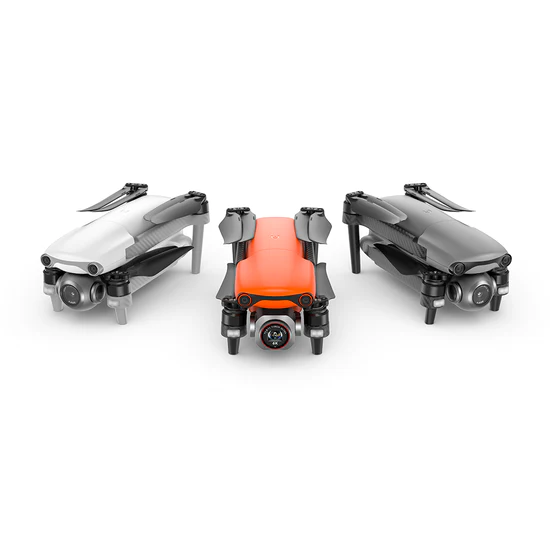
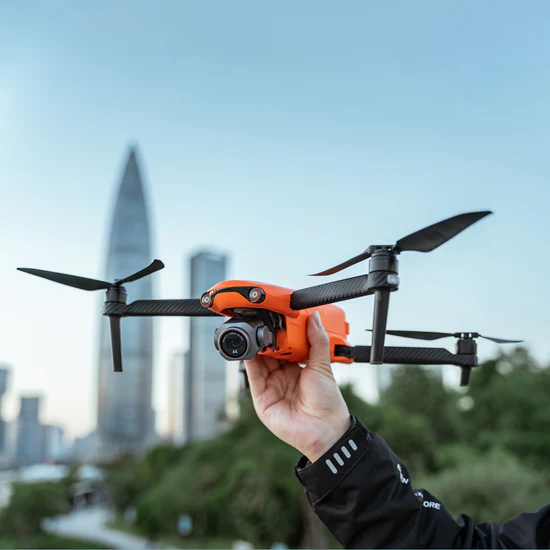
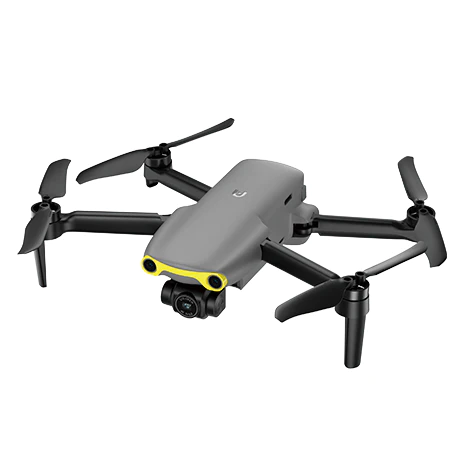

What is the price difference between the Mini 3 and Mini 3 Pro? The DJI Mini 3 starts at around $469, while the Mini 3 Pro is priced starting at $669, reflecting a $200 difference due to enhanced features in the Pro model.
What are the camera specifications for both drones? Both models feature a 12 MP camera with a 1/1.3″ sensor, but the Mini 3 Pro can shoot 48 MP photos and videos in 4K at 60 fps, compared to the Mini 3’s maximum of 4K at 30 fps.
Does the Mini 3 Pro have obstacle avoidance? Yes, the Mini 3 Pro is equipped with a robust obstacle sensing system that detects obstacles in four directions, while the Mini 3 only offers downward vision.
Which drone has better intelligent features? The Mini 3 Pro includes advanced features like ActiveTrack, Mastershots, and Hyperlapse, which are not available on the Mini 3.
Are both drones the same weight? Yes, both the DJI Mini 3 and Mini 3 Pro weigh 249 grams, making them portable and not requiring FAA registration.
How does the flight time compare? The Mini 3 offers a flight time of up to 38 minutes, while the Mini 3 Pro has a maximum flight time of around 34 minutes.
Can I use my existing DJI remote with these drones? Yes, if you own a compatible DJI remote, you can save on costs by purchasing just the drone without the remote controller.
Which drone is better for beginners? The Mini 3 may be more suitable for beginners due to its lower price and simpler features, while the Mini 3 Pro is ideal for those seeking advanced capabilities.
What is the difference in color profiles? The Mini 3 Pro supports a D-Cinelike color profile, beneficial for post-production color grading, which the Mini 3 lacks.
Are there any significant design differences? Both drones share a similar compact design, but the Mini 3 Pro includes additional sensors and a more premium finish.
Enhance safety and efficiency in power line inspections with advanced drone technology.

What is Synthetic Aperture Radar (SAR)? When people think of satellite images, they often picture colorful photos taken from space.

Understanding the differences between free satellite maps and powerful commercial satellite data for your needs in 2025. The world is constantly being watched from

The Plaza, Radisson Blu Hotel, Dubai Deira Creek, Dubai UAE

+971 58 885 3151

Specialized in satellite data, drone products, industrial products & supply chain management.
© Copyright 2025 by XrTech Group. All rights reserved.